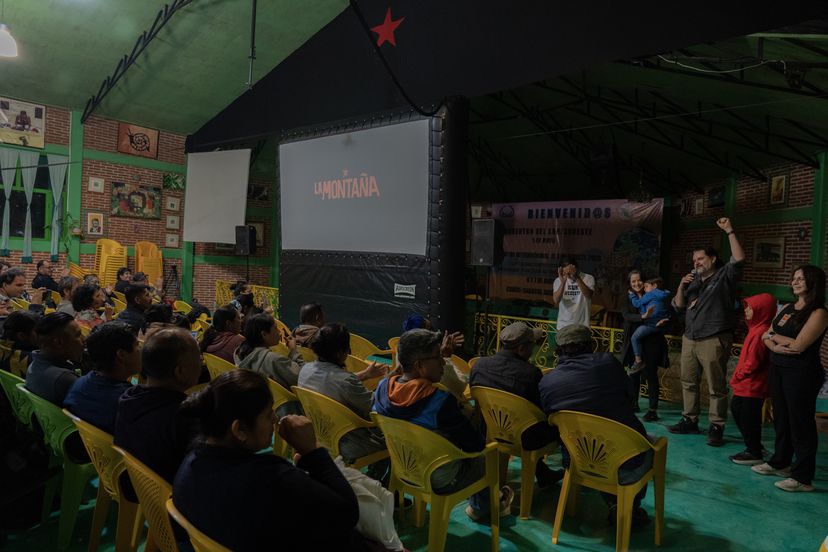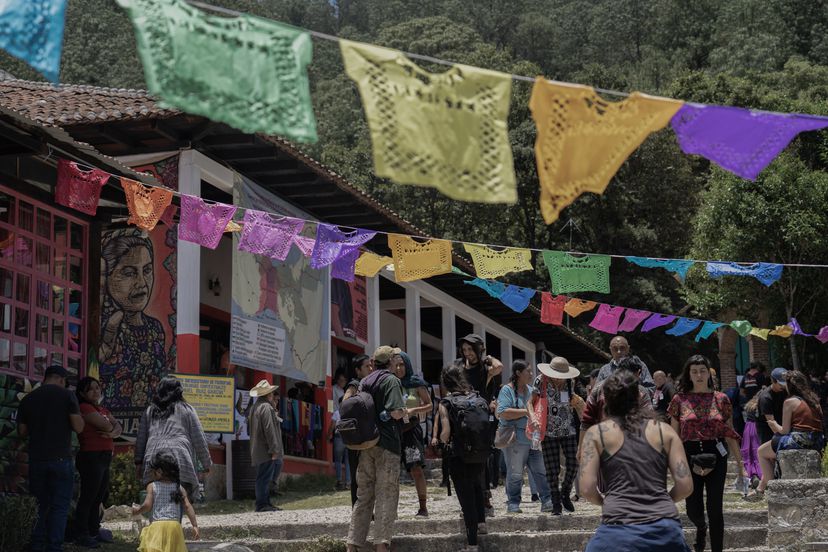Diego Enrique Osorno premieres ‘La Montaña’, a documentary about the EZLN’s 2021 boat trip to Europe, in a community of the guerrillas in Chiapas

Mónica González Islas
A dilapidated sailing ship sails across the Atlantic for the last time. Her compass points towards the European coasts. The calm waves of the ocean tenderly rock the white shell. In her entrails she hides five crew members and seven guerrillas from the Zapatista Army of National Liberation (EZLN) with a mission: to change the perspective to change the world. But this improbable voyage happened in 2021. Right now, on the first Saturday of May at Caracol Jacinto Canek, a stronghold of the Zapatistas in San Cristóbal de las Casas, Chiapas, hundreds of eyes do not misss a detail of the maritime adventure on an screen improvised for the occasion. The projector reveals for the first time in Mexico ‘La montaña’, the latest documentary by journalist Diego Enrique Osorno, a privileged witness along with the photographer María Secco of that unique trip.

Monica Gonzalez Islas
The premiere, only preceded by another at the Rotterdam Festival, is the declaration of intent of two old sympathizers of the Zapatista cause. The place and the public, too. This weekend, the Caracol —the name given to the EZLN’s administrative and government centers— welcomes militants from all over the world in a meeting organized by the Mexican National Indigenous Congress (CNI). It is the last stop on the path of El Sur Resiste, an internationalist caravan that has traveled these latitudes —Chiapas, Tabasco, Veracruz, Oaxaca, Campeche, Yucatán and Quintana Roo— in protest against the Mayan Train, the Trans-Isthmic Corridor and other megaprojects of the Government of Andrés Manuel López Obrador, who has been at odds with the EZLN for years.
The EZLN 4-2-1 squadron — four women, two men, and one non-binary person — set sail from the turquoise waters of the port of Islas Mujeres, in the Mexican Caribbean, on May 2nd, 2021. The world, which seemed to have forgotten in the chest of lost revolutions that group of indigenous guerrillas who tried to shake history, was still in retreat from COVID when they ventured into the Atlantic. The chronicles of that day say that the wind was blowing with a moderate breeze of 13 knots on the Beaufort scale and the sailboat headed south-southeast. Osorno and Secco were on board, armed with cameras and notebooks to record the log of a journey that nobody expected in a society disillusioned with the future and tired of the disease and death brought by the pandemic. 52 days later they docked in Vigo, Galicia. Zapatismo had landed in Europe.

The Zapatista Jacinto Canek Caracol during the International Meeting El Sur Resiste 2023, San Cristóbal de las Casas. Mónica González Islas
“We are not going to loot, we are going to sow”
The idea of the Zapatista journey was a kind of conquest in reverse, 500 years after the Spanish landed on these lands. “We are not going to loot, we are going to sow,” Lupita, one of the crew members, says on the screen. Go, see, listen to the other, learn how people survive, think, resist and fight on the other side of the ocean.
“The Zapatistas, in their initiative, are proposing a very simple and very precise thing: to remake the world.”
Osorno (42 years old) is sitting on the steps of the porch of a wooden cabin with colorful drawings, somewhat removed from the bustle that dominates the rest of the Caracol. Light is fading from the day as he reminisces about the journey. His characteristic silhouette, his graying beard, his sleeves rolled-up, stand out against the house. As he speaks, a handful of women carrying babies strapped to their bodies with cloths pass behind him. They look at him out of the corner of their eyes and listen discreetly.
“What struck me the most is the approach of changing the view. To change the world you first have to change the way you see it.”
The sailboat, also called La Montaña, carried the children and grandchildren of the guerrillas who took up arms in the 1990s. “It is a story of Zapatismo beyond stereotypes. The EZLN has almost always concentrated around the uprising of January 1st, 1994, the armed path they chose, for me with great consistency and legitimacy, but the movement goes far beyond all that mystique that was generated, of emblematic figures such as Subcomandante Marcos or Subcomandante Moisés. The film shows the new Zapatismo, what it has built”.

Mónica González Islas
The journey marked all the crew members. Osorno evokes the nightwatches at the helm, looking at the horizon in search of other ships. The turns cooking, the conversations between sailors—four Germans and one Colombian—and Zapatistas, the 360-degree view. As a counterpoint to the story, an anti-authoritarian captain with a touch of bar philosopher, who when the voyage was over retired to live as a peasant farmer in the Galician mountains. During the 22 days of the voyage, isolation was total. They had no communication with the outside world. “We didn’t know if life still existed on Earth. There was water, but we didn’t know if there was anything else.”
Center of Autonomous Resistance and Zapatista Rebellion
At the door of the Caracol there is a huge sign: Center for Autonomous Resistance and Zapatista Rebellion. A couple of guards cover the door. Once inside, the path loses its way through a community full of greenery and trees, at the foot of one of the mountains that surround San Cristóbal de las Casas. A group of children play in the sun on a soccer field. The place is also a popular school where kids from poor neighborhoods come to learn trades such as metalwork or carpentry. The path goes through a group of brick buildings decorated with bright colors and wooden cabins.

Mónica González Islas
The community has put on their Sunday bests for the meeting. There are colored flags along the way and hundreds of people from all over the world, sympathizers of Zapatismo. The hustle and bustle is much greater than on a normal day around here: stalls selling fanzines, notebooks, posters, T-shirts, handcrafts, postcards, almost everything related to the EZLN. However, there are no ski masks, tobacco pipes or shouldered rifles. The guerrillas have given up their space and then have disappeared, following the strategy of silence that they have maintained for years. Although they are present in every conversation and will be the icing on the day with the documentary.
“The film is the Zapatista present, a retrospective of what it has been and a projection of what they are looking for: to organize groups that are very different, but agree that this world must be remade. It is happening here, it is impressive to see collectives from Austria, Germany or Italy discussing with the assembly of the Isthmus of Oaxaca and trying to find parallels, generate meeting points and alliances to resist.”
La Montaña, as well as narrating the trip, outlines the history of Zapatismo through archive images as flashbacks. The seed that gave birth to the organization was planted on November 17th, 1983, but the world would not know them until a decade later: on January 1st, 1994, the same day that the Free Trade Agreement (FTA) entered into force. An army of thousands of campesinos took up arms and put the government of Carlos Salinas de Gortari in check. They wanted to put an end to the lacerating inequality suffered by indigenous people in Mexico and the unstoppable advances of globalization. Six years later, in 2001, a guerrilla delegation led by Subcomandante Marcos, a spokesman with a touch of the poet, paraded through the Zócalo in Mexico City, unarmed and surrounded by a million souls to demand autonomy in their territories, a decision that Congress would deny them weeks later.

Mónica González Islas
The Zapatistas saw the gesture as a betrayal that led them to break forever with the Mexican left. They withdrew to their territories and began to practice an independent form of government in their communities. They disappeared from the spotlight for a while. In 2006, they toured the country again, before the elections that would give power to Felipe Calderón. The EZLN, with Marcos once again at the helm, developed an initiative they called The Other Campaign, an attempt to create a front from the left against the traditional parties. It didn’t work. Since then, silence has been the strategy behind the scenes. Behind closed doors, the EZLN has continued working to consolidate its autonomy.
In 2012, to remind humanity that they were still there, a latent shadow in the jungles of Chiapas, thousands of EZLN members once again occupied the streets of San Cristóbal. “When the end of the world was predicted according to the Mayan calendar, about 50,000 Zapatistas descended and took the city, but in silence and without weapons,” recalls Osorno. In 2018, they promoted an indigenous candidate, María de Jesús Patricio Martínez, Marichuy, for the presidential elections, the same ones that her old adversary, López Obrador, won.
The Zapatista army is a strange one, determined to seek peace and avoid war, says a voice in the documentary. Instead of putting up barricades, for the past 30 years it has dedicated itself to building hospitals and schools. However, there is a sector of the left that criticizes that the movement has isolated itself in its communities, that it has turned its back on the world and has closed in on itself. “It seems schizophrenic to me,” Osorno replies, “they are traveling the world. At a time when countries and the left have become rancidly nationalist and closed, they still have the ability to go out and want to understand the other.

Mónica González Islas
And the truth is that in this small redoubt in the mountains of San Cristóbal you can breathe a different air. Hundreds of people from all over the world debate and share ideas: there is talk of the distribution of land and wealth, of saving nature and stopping the dispossession, laughter and revolutionary songs are heard under the sun. Outside the walls of the Caracol, life is different: a neighborhood of favelas with houses built by hand by their inhabitants, a grayer, sadder, impoverished and insecure world. A reflection of the new reality that haunts the mirage of peace in which Chiapas lived, now threatened by the specter of violence that runs through the rest of the country.
“The difference between what you are feeling here and what is happening 20 meters away is a context of economic violence, criminal groups, cartels, the security forces themselves… The Zapatistas are resisting and preserving the autonomy and dignified life they have built with lots of sweat and blood. Preserving peace and such direct democracy that they have had in this context is not a small thing, it is a shitload of work.”
When night begins to fall on the mountainside and the lights come on, life does not end in the Caracol. The murmur does not stop and the laughter is constant. And even if it is only for the time that a conversation lasts, for a day, for a weekend, within the walls of this village against the modern world and globalization, it is easy to catch that old idea that the hooded guerrillas of Chiapas shouted January 1st, 1994: maybe another world is possible.

Original article by Alejandro Santos Cid available at https://elpais.com/mexico/2023-05-07/noche-de-cine-en-territorio-zapatista-para-rehacer-el-mundo-y-un-velero-en-el-atlantico.html?outputType=amp
Translated by Schools for Chiapas.
